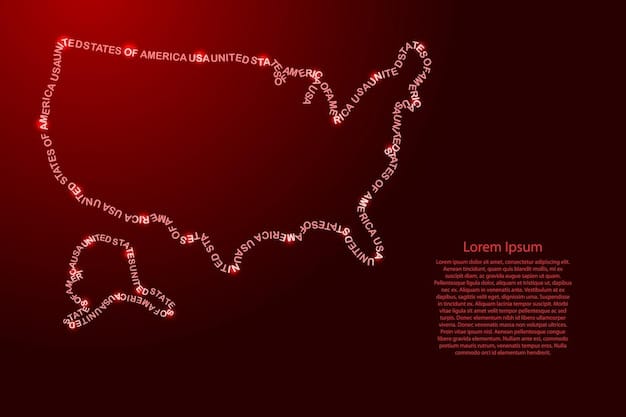Understanding Gerrymandering’s Impact: Representation in Public Policy Debates

Understanding the impact of gerrymandering on representation in public policy debates reveals how strategically redrawing electoral district boundaries can dilute the voting power of certain groups, leading to skewed political outcomes and hindering fair representation in policy decisions.
Understanding the impact of gerrymandering on representation in public policy debates is crucial for anyone interested in fair elections and equitable governance. This article explores how this practice affects political representation and the resulting consequences on public policy.
What is Gerrymandering?
Gerrymandering, in essence, is the manipulation of electoral district boundaries to favor one political party or group over another. This practice, which dates back centuries, can significantly distort the democratic process and impact the fairness of elections.
The term “gerrymandering” was coined in 1812 after Massachusetts Governor Elbridge Gerry approved a redistricting plan that created a district resembling a salamander. A political cartoonist then dubbed it a “Gerry-mander,” and the name stuck. Today, the issue continues to spark debate and controversy due to its potent effect on political outcomes.
Historical Roots of Gerrymandering
The historical roots of gerrymandering can be traced back to the early days of American politics. Understanding its evolution through time helps to contextualize its contemporary relevance. Consider:
- Early Examples: Even before the term was coined, redistricting was used strategically to gain political advantage.
- 19th Century Developments: As political parties solidified, so did their efforts to control district boundaries for electoral gain.
- 20th Century Expansion: The advent of computers and geographic information systems (GIS) allowed for increasingly sophisticated gerrymandering techniques.
Common Techniques Used in Gerrymandering
Several techniques are employed to gerrymander districts. Recognizing these methods is key to understanding how the practice distorts representation. The most common are:
- Cracking: Dividing a group’s voting base among multiple districts to dilute their influence.
- Packing: Concentrating a group’s voting base into a single district to reduce their influence in surrounding districts.
- Stacking: Merging disparate groups into a single district to prevent any one group from achieving a majority.
Gerrymandering continues to be a significant challenge for fair and equitable elections. By manipulating district lines, political parties can secure an advantage that undermines the democratic principle of equal representation.
The Impact on Voter Representation
Gerrymandering significantly impacts voter representation by undermining the principle of “one person, one vote.” When district lines are drawn to favor a particular party, the voices of voters in the opposing party can be effectively silenced.
This distortion of representation can lead to a political climate where elected officials are more accountable to their party than to their constituents, exacerbating partisan divides and gridlock.
Dilution of Minority Votes
One of the most concerning effects of gerrymandering is the dilution of minority votes. This often occurs when district lines are drawn to either “crack” or “pack” minority voters, reducing their ability to elect their preferred candidates.
- Reduced Influence: Gerrymandering can diminish the impact of communities of color, who are often already marginalized in the political process.
- Legal Battles: Many gerrymandering cases have been challenged in court under the Voting Rights Act, which aims to ensure equal access to the political process for all citizens.
- Underrepresentation: By limiting the voting power of minority groups, gerrymandering can lead to fewer minority representatives in state legislatures and Congress.
Reduced Electoral Competition
Gerrymandering often results in districts that are overwhelmingly partisan, reducing the incentive for elected officials to appeal to a broad range of voters. This can lead to:
- Safe Seats: Many districts become “safe seats” where the outcome of the election is virtually predetermined.
- Decreased Accountability: Elected officials in safe seats may feel less accountable to their constituents, as they are less likely to face a serious challenge in the general election.
- Increased Polarization: The lack of competitive elections can contribute to increased political polarization, as elected officials cater to their party base rather than seeking common ground with the opposition.
Ultimately, the manipulation of district lines can erode public trust in the electoral process, leaving many voters feeling that their voices do not matter. Fair districting practices are essential to ensuring that every vote counts and that all communities have a fair chance to elect their preferred candidates.
Public Policy and Gerrymandering
Gerrymandering significantly influences public policy decisions. When district lines are manipulated, the resulting skewed representation can either amplify certain policy agendas or suppress others.
This can lead to policy outcomes that do not reflect the will of the majority of voters but rather the preferences of the party or group that controls the redistricting process.
Impact on Legislative Priorities
Gerrymandering can shape legislative priorities by altering the composition of legislative bodies. Consider these implications:
- Skewed Agendas: Legislators from gerrymandered districts may focus on issues that appeal to their narrow base rather than addressing broader community needs.
- Policy Polarization: Gerrymandering can lead to more polarized policy debates, as elected officials are incentivized to take more extreme positions.
- Reduced Compromise: The lack of competitive elections can make it more difficult for legislators to find common ground and compromise on important policy issues.
The Fate of Bipartisan Legislation
Bipartisan legislation often requires a level of cooperation and compromise that becomes increasingly difficult in a gerrymandered political landscape. Examine the following impacts:
- Limited Appeal: In districts where one party has a significant advantage, legislators may be less willing to support bipartisan measures that could alienate their base.
- Gridlock: The increased polarization resulting from gerrymandering can lead to legislative gridlock, where important issues are left unaddressed.
- Missed Opportunities: The focus on partisan priorities may prevent lawmakers from seizing opportunities to collaborate on mutually beneficial policies.

The influence of gerrymandering extends far beyond election outcomes, shaping the very nature of public policy and governance. Addressing gerrymandering is essential to ensuring that public policy reflects the diverse needs and preferences of all communities.
Legal Challenges to Gerrymandering
Legal challenges to gerrymandering have become increasingly common as advocates seek to curb its impact on fair representation. These challenges often focus on the constitutional principles of equal protection and voting rights.
While the Supreme Court has acknowledged the problem of partisan gerrymandering, it has struggled to develop a clear standard for determining when a redistricting plan violates the Constitution.
Key Supreme Court Cases
- Davis v. Bandemer (1986): The Supreme Court ruled that partisan gerrymandering claims are justiciable but set a high bar for proving unconstitutionality.
- Vieth v. Jubelirer (2004): The Court was divided on whether a workable standard existed for evaluating partisan gerrymandering claims.
- Gill v. Whitford (2018): The Court remanded the case due to lack of standing but did not resolve the underlying issue of partisan gerrymandering.
The Role of State Courts
Given the Supreme Court’s reluctance to intervene, state courts have played an increasingly important role in addressing gerrymandering claims. Several state courts have struck down gerrymandered maps based on state constitutional provisions guaranteeing fair elections and equal protection.
- Pennsylvania Supreme Court: In 2018, the court invalidated the state’s congressional map, finding that it unfairly favored Republicans.
- North Carolina Supreme Court: The court has also invalidated congressional and legislative maps on multiple occasions, citing partisan gerrymandering concerns.
- State Constitutional Grounds: These rulings highlight the importance of state-level protections for voting rights and fair elections.
Despite the legal challenges, gerrymandering remains a persistent issue in American politics. The legal landscape is constantly evolving, and future court decisions will likely shape the future of redistricting reform.
Potential Reforms and Solutions
Several potential reforms and solutions are being proposed to address gerrymandering, each with the aim of promoting fairer and more competitive elections. These approaches range from independent redistricting commissions to legislative changes.
Ultimately, the goal is to create a process that is transparent, accountable, and designed to ensure that district lines are drawn in a way that accurately reflects the diversity and preferences of the electorate.
Independent Redistricting Commissions
Independent redistricting commissions are often seen as a promising solution to gerrymandering. These commissions, typically composed of non-partisan members, are tasked with drawing district lines in a way that is free from political influence.
- Arizona: The state has an independent redistricting commission that has been credited with creating more competitive districts.
- California: Similarly, California’s commission aims to ensure fair representation and minimize partisan bias.
- Iowa: Iowa’s non-partisan Legislative Services Agency draws district maps based on neutral criteria.
Legislative and Constitutional Amendments
In addition to independent commissions, legislative and constitutional amendments can establish clear criteria for redistricting, such as compactness, contiguity, and respect for communities of interest.
- Compactness and Contiguity: Requiring districts to be geographically compact and contiguous can prevent the creation of oddly shaped districts that are designed to favor a particular party.
- Communities of Interest: Protecting communities of interest ensures that district lines do not divide neighborhoods or cultural groups.
- Transparency: Making the redistricting process more transparent can help to prevent gerrymandering and increase public trust in the electoral system.
By implementing these reforms, it is possible to create a more level playing field for elections and ensure that every vote carries equal weight.
The Role of Technology and Data in Gerrymandering
The rise of technology and data analytics has both exacerbated the problem of gerrymandering and offered potential solutions. Advanced mapping software and voter data can be used to draw districts with surgical precision, but they can also be used to detect and challenge gerrymandered maps.
It is important to understand the role that technology plays in both driving and combating gerrymandering in order to develop effective strategies for reform.
Geographic Information Systems (GIS)
- Mapping and Analysis: GIS software allows mapmakers to analyze demographic and political data with a level of precision that was not possible in the past.
- Predictive Modeling: By incorporating voter data, GIS can be used to predict how different redistricting scenarios will affect electoral outcomes.
- Data Visualization: GIS can also be used to create compelling visualizations of gerrymandered districts, making it easier to understand the impact of the practice.
Data Analytics and Voter Information
- Targeted Redistricting: Data analytics can be used to identify and target specific groups of voters for either “cracking” or “packing.”
- Voter Modeling: By analyzing voter behavior, data analysts can create models that predict how individuals are likely to vote, allowing mapmakers to fine-tune district lines.
- Campaign Strategies: Technology and data can also be used to support campaigns aimed at raising awareness about gerrymandering and advocating for reform.
As technology continues to evolve, it will be increasingly important to ensure that it is used to promote fair elections and protect voting rights, rather than to entrench partisan advantages.
| Key Point | Brief Description |
|---|---|
| 🗳️ What is Gerrymandering? | Manipulating district boundaries to favor a political party. |
| ⚖️ Legal Challenges | Challenges often focus on constitutional principles. |
| 🗺️ Impact on Representation | Undermines “one person, one vote.” |
| 🤖 Role of Technology | GIS and data analytics impact districting precision. |
Frequently Asked Questions
▼
The primary goal of gerrymandering is to manipulate the boundaries of electoral districts to give an unfair advantage to one political party or group over another, thereby securing or maintaining political power.
▼
Gerrymandering can dilute minority voting power through “cracking,” splitting minority communities across districts, or “packing,” concentrating them into a single district to reduce their influence in surrounding areas.
▼
Independent redistricting commissions are non-partisan bodies responsible for drawing electoral district boundaries without political bias. They aim to create fair and competitive districts, reducing the impact of partisan gerrymandering.
▼
Legal challenges to gerrymandering often argue that it violates the principles of equal protection and voting rights under the Constitution. Cases like Davis v. Bandemer have addressed the justiciability of such claims.
▼
GIS and data analytics enable precise mapping and analysis of demographic and political data, allowing for targeted redistricting. This technology can either exacerbate gerrymandering or aid in detecting and challenging unfair maps.
Conclusion
Understanding the impact of gerrymandering on representation in public policy debates is essential for fostering a fair and equitable democratic process. By recognizing the techniques and consequences of gerrymandering, advocating for reforms such as independent redistricting commissions, and staying informed about legal challenges, we can work towards ensuring that every vote counts and that all communities have a voice in shaping public policy.





